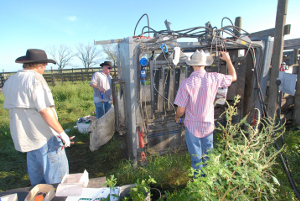- Return to Article Of The Month index
Reducing Handling Stress Improves Livestock Productivity
March, 2016
Bridget Stice, UF/IFAS Extension Agent, Polk County
 As we head into the marking and branding season, now is a good time to think about the impact of stress on cattle productivity. Stress induced by handling agitates and excites animals, resulting in elevated body temperature, increased heart rate, high glucocorticoid values, and reduced immune function. This all translates into reduced productivity which costs money. Aggressive handling can also lead to facility damage and require more handlers or employees to move cattle, thereby increasing costs. Low stress handling will reduce injury to handlers as well as to livestock. Improved handling alleviates unnecessary stress (and stress’ inherent health risks) to the animal and allows the producer to move cattle more efficiently and effectively. That means time and time means money.
Not only does low-stress cattle handling make good economic sense, it is the right thing to do. Today’s consumer is concerned with the welfare of the animals that are the source of their food. Public perception is paramount to the survival and sustainability of the beef industry. Consumers are more accepting of low-stress handling techniques when compared to aggressive handling.
As we head into the marking and branding season, now is a good time to think about the impact of stress on cattle productivity. Stress induced by handling agitates and excites animals, resulting in elevated body temperature, increased heart rate, high glucocorticoid values, and reduced immune function. This all translates into reduced productivity which costs money. Aggressive handling can also lead to facility damage and require more handlers or employees to move cattle, thereby increasing costs. Low stress handling will reduce injury to handlers as well as to livestock. Improved handling alleviates unnecessary stress (and stress’ inherent health risks) to the animal and allows the producer to move cattle more efficiently and effectively. That means time and time means money.
Not only does low-stress cattle handling make good economic sense, it is the right thing to do. Today’s consumer is concerned with the welfare of the animals that are the source of their food. Public perception is paramount to the survival and sustainability of the beef industry. Consumers are more accepting of low-stress handling techniques when compared to aggressive handling.
To reduce stress during handling, it is important to understand the factors that cause stress. Stress factors include genetic background, individual differences, past experiences, and familiarity with the environment. Studies have shown that highly agitated cattle tend to produce highly agitated offspring. Studies have also shown that some breeds of cattle are more susceptible to agitation than others. This is a result of genetics. However, within a breed each animal has individual characteristics or temperament. As a result, some animals are more intensely affected by stress than others. Therefore, if an animal is persistently agitated, she should be culled from the herd.
Cattle have long memories, so past experiences can have a significant impact on how they react to situations. If they are handled roughly in the past, they will be more difficult to handle and stress more easily. Lastly, familiarity with the environment has an impact on the degree of stress that an animal will exhibit. Cattle exhibit stress when introduced to new environments. That stress can be reduced by not forcing cattle immediately through a novel environment. Having an understanding of these factors that impact stress in animals is key to reducing stress.
Reducing stress also depends on our attitudes, methods and understanding of how an animal behaves. Cattle are prey animals. Their eyes are shaped differently and are located on the sides of their head. Cattle have excellent peripheral vision. However, they do have blind spots directly behind them and directly in front of them. It is important that handlers remain in the line of sight of cattle to reduce stress.
It is also important to understand a cow’s flight zone (the “bubble” around an animal that, if invaded, will cause the animal to move away) and the point of balance (the point, usually around the front shoulder, at which pressure in front of that point will cause the animal to stop or backup, and vice versa). The size of a flight zone varies among animals. Located at the edge of the flight zone and at the point of balance, a rancher need only make slight movements to control the movement of the animals.
Cattle are herd animals. They want to go with and will go to other cattle. Ranchers can take advantage of this natural instinct by working from the front of cattle. Starting at the front, the cattle in the back will follow. This is why it is also unwise to leave one animal alone in the pen.
Facilities should be designed and used to encourage low-stress handling. Cow pens must be sturdy enough to contain the most aggressive animal in the herd. Solid sides on both the single file chute and the squeeze chute will facilitate cattle movement and reduce lunging at the headgate. To reduce balking, distractions which impede cattle movement must be eliminated from handling facilities. Some of the most common distractions which make cattle balk in a chute are: a jiggling chain hanging in a chute, shiny reflections on metal, puddles, shadows, seeing a visible person, a jacket or other garment hanging in the chute, and high pitched noises. Cattle should be moved into the handling facility in small groups and the crowd pen should be filled only half to three-quarters full.
Reducing handling stress of animals will improve their weight gain, reproductive performance, and ability to resist disease. Rough handling, agitation, and excitement during loading for transport or health care procedures can impair the performance of animals.
Photo courtesy: Mark Davis, DVM

